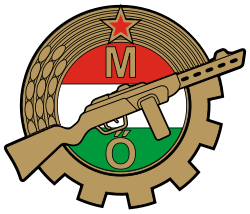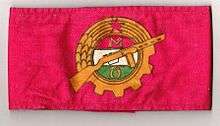Workers' Militia


The Workers' Militia Hungarian: Munkásőrség was a paramilitary organization in the Hungarian People's Republic from 1956 to 1989.
Following the quelled Hungarian Revolution of 1956, the Revolutionary Workers'-Peasants' Government ordered on February 18, 1957 the formation of the Workers' Militia. It replaced the revolutionary regime's special police force (karhatalom or also known as pufajkások, named after their Soviet-style quilted jackets). The slate-grey uniformed and armed Militia's aim was to defend the means of production. It was a voluntary service, but obviously offered some career advantages. Starting with 20,000 members, it gradually developed into a large armed force (60,000 strong), although they were never deployed.
The first commander of the organization was Lajos Halász (1957–1962), followed by Árpád Papp (1962–1970), then lastly Sándor Borbély (1970–1989).
On October 31, 1989, a referendum was held with the question: “Should the Workers' Militia be disbanded?”. The answer was an overwhelming Yes (94.9%), a result which confirmed the previously-adopted law (1989 XXXth).
See also
- Eastern Bloc politics
- Combat Groups of the Working Class (East Germany)